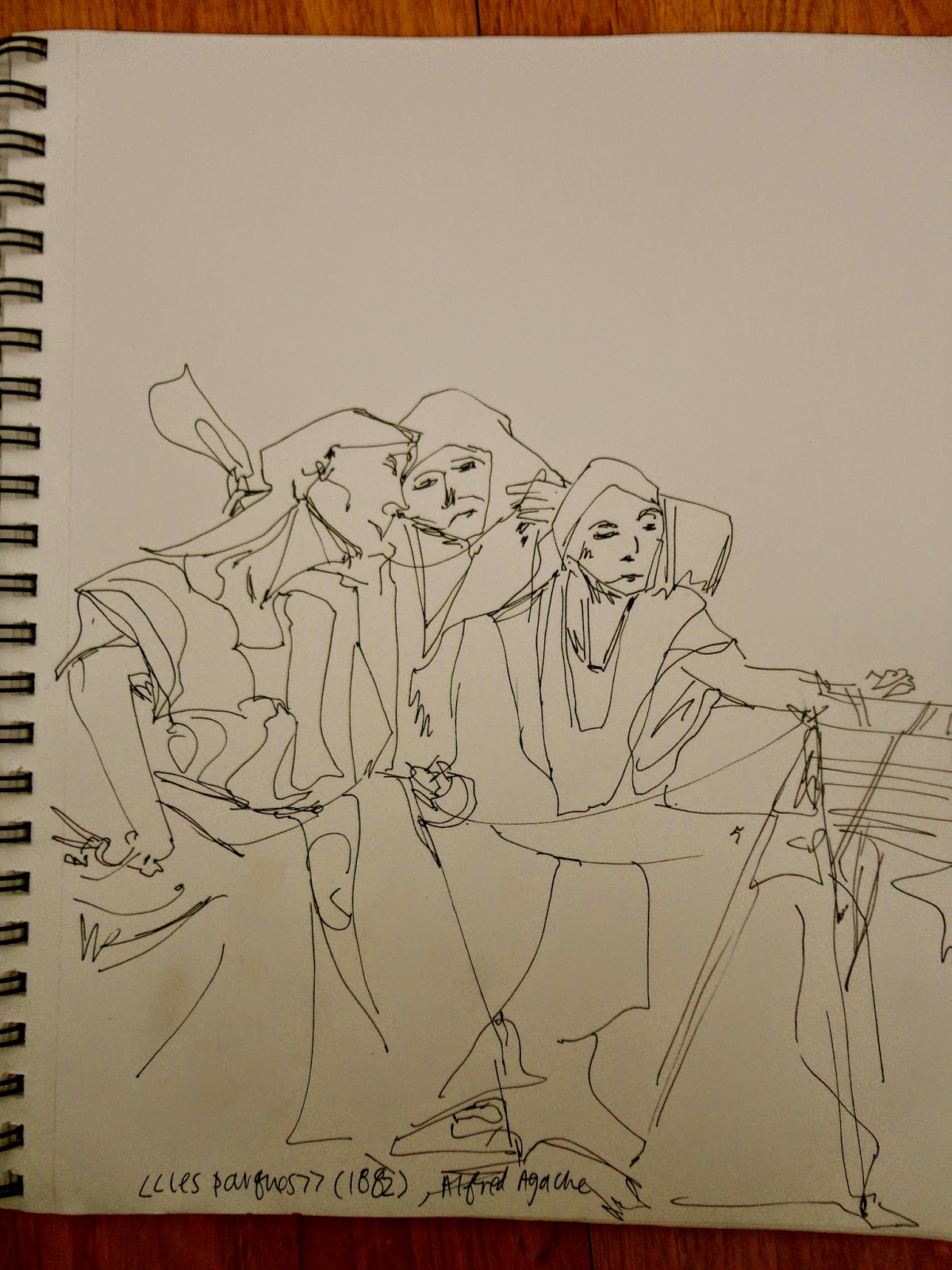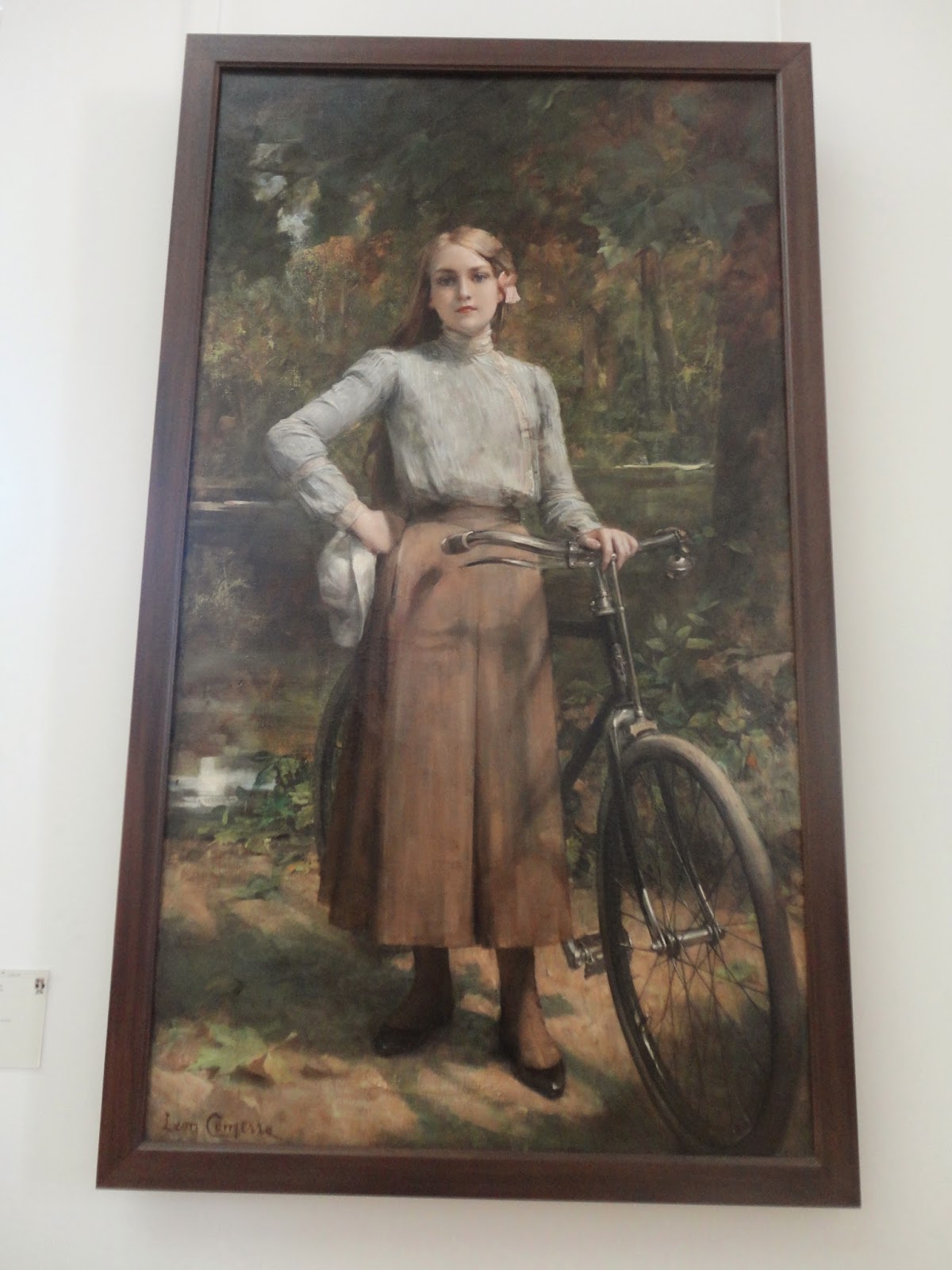| charcoal and pastel, 16.5" x 23.5" |
Tuesday, April 8, 2014
Art Embodied: anatomical drawing 5
This piece, the fifth anatomical drawing for my independent study project 'Art Embodied,' is based on my studies of Realism and Impressionism. While the aesthetic of this drawing may seem more impressionistic than realistic, conceptually it is founded in Realism. The female figure holds a picture frame to her torso to represent the Realist artist's committment to depicting everyday life accurately. The Realist's aim was to translate the physical world to the canvas in a streamlined, honest and occassionally simplified way. In this drawing the process of transposition is taken to an efficient extreme — the real-life subject is simultaneously the work of art.
Art Embodied: Realism
Let's be realistic. This week I visited the Petit Palais, a totally cool Parisian art museum boasting art from Antiquity through the 19th century. This week for my independent study project 'Art Embodied,' I've been exploring the Realist movment. I'll start off with a hyper-realist piece, in fact, a photograph, of the Petit Palais garden, just to set the scene:

Realist painters sought to depict their world accurately and honestly, yet it was not a movement where human anatomy was heavily featured. The majority of figures are at least passably anatomically accurate, or at least don't possess anatomical errors evident to my untrained eye. The primary subject matter is not the physcial human body, however, but the everday existence of people on the lower rungs of the social heirarcy.
Perhaps more relevant to my studies of the human figure for this independent project are the more general stylistic trends of Realist art. The works themeselves, and thus the human figures in the works, are painted in a naturalistic yet simplified manner. The girl with her bike in the painting below, 'Bicyclette au Vesinet' painted by Leon-Francois Comerre in 1903, is an example of the Realists' simultaneous rejection of the idealism and technicality of Neoclassist Art and the dramatic and exotic themes of Romantic Art. The Realists opted for a modest and deliberately simple style instead.
By the late 1870s realism was drained of much of it's political poignancy. Realists continued to portray contemporary life, but their choice of banal subject matter no longer carried the same surprising punch and no longer rocked the social heirarchy of the day. Realism began to die down at the turn of the century, but despite it's shortlived hayday it continued to influence future artists such as Manet and many other Impressionist painters.
Realism emerged in France during the 1840s, reverberated throughout Europe and across the Atlantic, meshed with Impressionism during the later quarter of the 19th century, and fizzled out at the end of the 1800s.
The emergence of Realism aligns with a time of political turmoil in France. During the 1840s revolutionaries ousted Louis-Phillipe in favor of Napoleon III, who launched the Second Empire. The working class gained voice as the revolution destablized the social heirarchy in France.
As is so often the case, the artistic trends aligned with political and cultural phenomenon. Previous artistic movements such as Neoclassisim and Romanticism had found inspiration in Antiquity, nationalism, religion, and narrative. With the voice of the proletariat growing ever louder, it was time for the working class to take the artistic spotlight. Realist artwork, such as 'Porteurs de Farine — Scene Parisienne' (below), painted by Louis-Robert Carrier Belleuse in 1885, exploded onto the art scene.
To further illustrate the way realist art turned the artistic lens toward contemporary life with a focus on the common man, below is a sketch I made of a single working-class figure in 'La Paye de Massonneurs,' painted by Leon Lhermitte in 1882.
During the realist era the artist adopted a truthful, objective point of view. The artist sought to depict contemporary life as it truly was. In stark contrast to earlier art of the 19th century, which looked to historical art and narrative for inspiration, realism found inspiration in the present day. One could say that the role of artist was humble during this time — the artist's primary purpose was not to interpret scenes or relay moral messages, but rather to reflect life as it was. The artist functioned as the scribe, not the judge. It follows that accuracy was a highly valued skill for artists during this time. Below is a painting at the Petit Palais titled '43 Portraits of Students of the Gleyre Workshop.' Charles Gleyre, the teacher, encouraged his students to sharpen their accuracy by painting the facial features of one another. This piece was made between 1860 and 1868, and features a number of Gleyre's students, including Sisley, Renoir, Whistler and Monet.
As mentioned above, realist art frequently illustrates the life of the working class. Jean-Francois Millet and members of the Balzac School depicted rural life. Other artists remained in the city and faithfully painted the harsh realities of the lives of the urban working poor. Below is a sketch I made of a realist painting by Alfre Agache called 'Les Parques', painted in 1882.
The working class equally dominates the canvases of Fernand Pelez, another realist-era artist. The painting below is titled 'Grimaces et Miseres, Les Saltimbanques,' and was executed by Pelez in 1888. Pelez became swept up in the naturalist undercurrent of art that emerged in the 1880s. Much of his art focuses on the lives of children of the street. In this work critics believe he sought to depict the rude existence of circus people such as clowns, musicians and other performers. Perfect depiction of anatomy or glorification of the human body was not Pelez' ultimate goal here. Instead he sought to illustrate the crude life of these anonymous characters. The painting is directly below, followed by a sketch I made based on the same work.
Realist painters sought to depict their world accurately and honestly, yet it was not a movement where human anatomy was heavily featured. The majority of figures are at least passably anatomically accurate, or at least don't possess anatomical errors evident to my untrained eye. The primary subject matter is not the physcial human body, however, but the everday existence of people on the lower rungs of the social heirarcy.
Perhaps more relevant to my studies of the human figure for this independent project are the more general stylistic trends of Realist art. The works themeselves, and thus the human figures in the works, are painted in a naturalistic yet simplified manner. The girl with her bike in the painting below, 'Bicyclette au Vesinet' painted by Leon-Francois Comerre in 1903, is an example of the Realists' simultaneous rejection of the idealism and technicality of Neoclassist Art and the dramatic and exotic themes of Romantic Art. The Realists opted for a modest and deliberately simple style instead.
When the human body was featured, such as in the painting below, it was commonly shown in a true-to-life but simplified, manner. 'Le Sommeil' was painted by French Realist poster child Gustave Courbet in 1866. Possibly inspired by Ingres' neoclassical work 'Le Bain Turc,' Courbet's painting of two female nudes is sensual and intimate. One major differnece is the context — a private bedroom rather than an oriental bath. This choice reflects the sensible, modest and banal inclinations of the realist artist.
By the late 1870s realism was drained of much of it's political poignancy. Realists continued to portray contemporary life, but their choice of banal subject matter no longer carried the same surprising punch and no longer rocked the social heirarchy of the day. Realism began to die down at the turn of the century, but despite it's shortlived hayday it continued to influence future artists such as Manet and many other Impressionist painters.
Sunday, April 6, 2014
Subscribe to:
Posts (Atom)
